I’m very pleased to present this blog’s first interview, recorded over the course of several visits to the home of Mr. and Mrs. B. P. Appanna in Kodagu.
Mr. Appanna is a retired professor of History, former president of the Karnataka Kodava Sahithya Academy, and a collector and custodian of some very unique cultural treasures of Kodagu. Having spent a lifetime teaching in schools and colleges across Coorg, Bacharaniyanda P. Appanna shows no signs of being anywhere near ready to sit back and enjoy a sedate retirement.
We’re seated in his office, and in the background, I can hear Mrs. Appanna, (also a retired teacher but currently the very active president of the Kodava Mahila Sangha), fielding phone calls, fixing appointments for various cultural and social engagements she and her husband are to attend. “There is never enough time to do everything!” laughs Mr. Appanna.
The gentleman wears his 75 plus years with the air of an outdoorsman. Trim and straight backed, he could easily be taken for a retired army officer. It’s when he begins to talk and recount the origins of his collection that one gets a glimpse of the teacher, communicating with clarity, emphasis and an enthusiasm that makes me think his students were very lucky indeed!
His story began in a tiny village near Cherambané, on the way to Bhagamandala. Born, according to school records, on the 12th of April 1935, Mr. Appanna was the youngest of four children born to Bacharaniyanda Ponnappa and his third wife, Gangamma. Maternal and infant mortality were high in those days and his father’s first two wives had passed away, leaving him with one surviving child from the second marriage.
“It was a remote corner of Kodagu”, Mr. Appanna begins. “We lived in Paaka, a sub-village that was bordered on the western side by very dense forest. This forest was known as ‘Iruli Bana’ (lit. onion forest) and there are many local legends attached to it. It was like a Devara kaadu (sacred grove). No one was allowed to enter the forest and the story goes that anyone who entered would not return.”
The family lived in a rambling house with thick mud walls and an even thicker thatched roof. It was the very last house in the village, and closest to the forest. When he was a just a year old, his father passed away. The responsibility for raising the five children and running the homestead fell on his mother. Depending solely on working the land to support the family, this was a huge challenge by any measure – particularly so for his young mother who had been raised in the comfort of a town environment. It was a harsh existence. In this semi-wilderness, it was a common occurrence for livestock to be attacked by predators from the nearby forest. Cattle were routinely lost to prowling tigers. Cows, calves and pigs were corralled around the house at night, watched over by the house dogs.
Recollecting incidents from his childhood, Mr. Appanna remembers how, one night, a cow was attacked by a panther. The ensuing commotion led his mother to head out into the pitch darkness to try and save the poor creature. She was armed with only a billhook and a small oil lamp to light the way. One of the little dogs that guarded the house followed. His mother was unable to save the cow and sadly, both cow and dog were carried away.
“My mother had lost her sight in one eye, but still she did not hesitate to venture out. That is the way it was”. Respect and admiration for her show plainly on his face. And, just in case you’re imagining some kind of romantic frontier lifestyle, ” It was horrible!” he exclaims, emphatically.
Mr. Appanna had an thirst for schooling that was impossible to satisfy in the village of Paaka. His father had served in the revenue department and his mother could read and speak English. But all that there was in the village was a thatched hut that served as a makeshift school, with classes that only went up to standard 4. (This was at a time when there were only 6 high schools in Coorg). A precocious student, by the time Mr Appanna was in standard 1, he was being asked to fill in as a substitute teacher for standard 4, teaching Kannada and mathematics to his seniors!
What followed is a remarkable, self driven quest for an education ( material enough for another interview ) and then, fittingly enough, a life dedicated to teaching.
A turning point
Some time in 1966, on a visit back to his home village, Mr. Appanna came upon the construction work of a new house on the site of the old family home. The huge mud walled structure with a thatched roof had been demolished, the contents of the old house lay scattered about. Something about the sight moved him deeply.
“I thought to myself, my ancestors lived here through terrible times. They were not ordinary people. These articles were a part of their lives, why should they be thrown out? Why should I not preserve what I can?”
He picked up a few pieces, including a spear and a kuri kutt (container for sacred ash) from the home. He washed them down and put them away. This marked the beginning of his drive to gather and preserve the trappings of rural life in Kodagu for posterity.
Showing the same determination with which he had pursued an education, Mr. Appanna kept an eye out for whatever he could salvage from homes that were in the process of being torn down. With work commitments and a young family to raise, it wasn’t always possible to be in the right place at the right time.
“Unfortunately, by the time I could really begin to devote more time to collecting, in the 1980’s, most of the old mud and thatch houses had been demolished and the contents destroyed or thrown away.”
While many laughed at what they considered an eccentric habit of collecting “junk”, friends would seek him out if they found something they thought might be of interest to him . Today, his collection runs into scores of pieces, made up of basketry, agricultural implements, pottery, weights and measures, containers for storing grain, salt and jaggery, water pots and liquor flasks. There are musical instruments, small pieces of furniture, cooking utensils, weapons and more. It is an fascinating medley of everyday objects from a bygone era. To Mr. Appanna, no object was too small or insignificant. He even collected carbonized paddy, recovered from a storage jar that was buried in the floor of a house torched in an village feud!
What is even more remarkable is his passion for communicating precisely what each and every object represents in a historical context. When I ask what his favourite piece is, the answer, not surprisingly, is not one of the larger, more spectacular pieces, but the tiny woven cane boxes used for coins and trinkets that get first mention.
“They are so beautifully made, so intricate. Also the marada duddi, (a wooden drum), that produces such a wonderful sound.”
Having a personal fondness for pottery, I find my favourites are among these fragile pieces – a water bottle shaped like a turtle, a thickly thrown eating bowl, and a wonderful clay chekala (steamer) which is most unusual, the norm being copper or brass.
“There was very little metal in my village in those days”, explains Mr.Appanna. “People could not afford much, so most utensils were made of clay. The village kumhara (potter) would make whatever was required.”
Pointing out what looks like a bowie knife, he says “That was given to women for self defense, but they had to learn how to hit a target at twenty paces before they were allowed to wield one.”
Fair enough, I’d say!
He holds up a beautiful basket made for trapping fish. “I’m a little rusty now, but given a little free time, I can still make one of these. Everyone in the village knew how.”
Mrs Appanna shows me a charmingly carved mukkali (three legged stool) in their home. “I am interested too, but I leave the collecting to him” she says with a smile. Their daughter Vindhya, who lives overseas, shares her parents’ interests and has a few selected pieces from her father’s collection beautifully displayed in her home.
Plans for posterity
“Sometimes people want to buy the pieces, but I ask them, ‘Do you know what the significance of this is? What it was used for? How it is made?’ I have lived with or seen most of these things in use.” It is clear he does not want his collection to be viewed merely for their antique value, or to be locked away in a rarefied museum atmosphere. Mr. Appanna hopes to establish a small museum of his own, an interactive place, with the idea that it will serve to educate and inform people about a way of life that has all but disappeared.
At present, the lack of a display space means a lot of time and effort is involved on the part of the owners in showing the pieces. The couple has been very generous in loaning pieces from their collection to various cultural events over the years, but damage from travel and mishandling of fragile objects is a constant worry.
As each visit draws to a close, I echo Mr Appanna’s earlier statement “There is never enough time! ” In this case, to see and hear about everything in this wonderful collection and to enjoy the endless fund of anecdotes from a gifted storyteller.
I’d like to thank Mr. and Mrs. Appanna for their generosity and kindness in sharing so much time with me and sincerely hope their wish for a suitable place to build their museum is granted. This fast paced modern world needs more windows to the past like these.
Oh, and I look forward to another of those delicious lunches!*
* Watch this space for a recipe from the Appanna household.

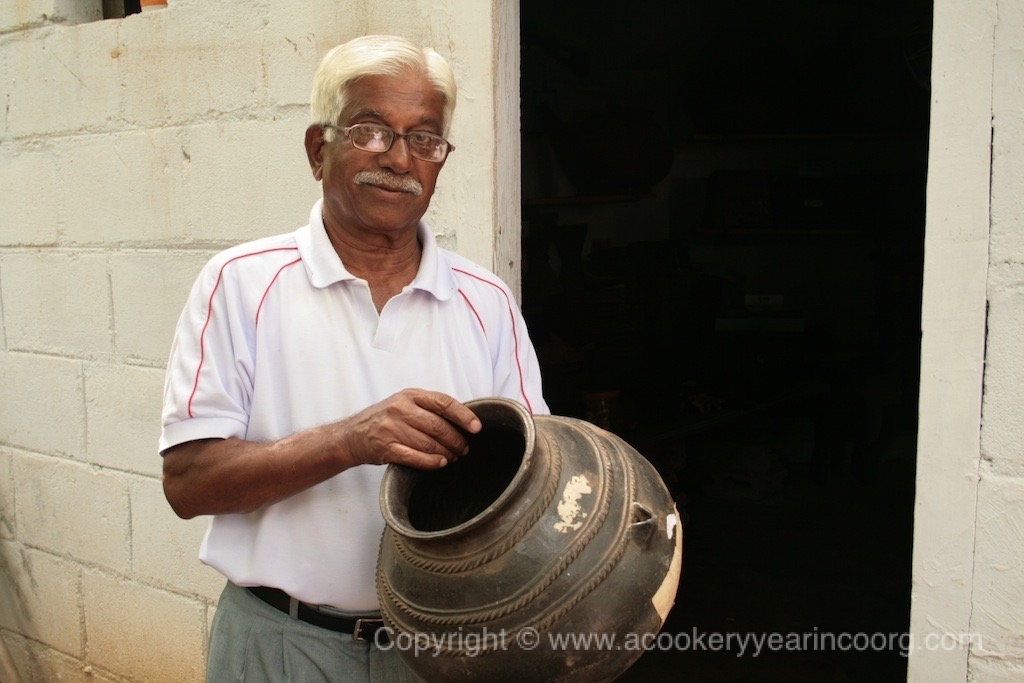
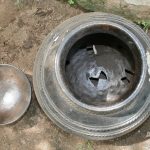
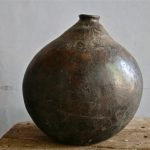
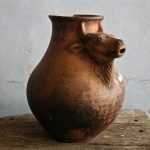
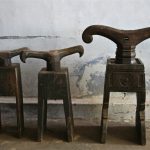
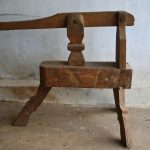
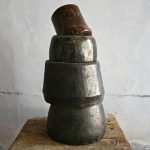
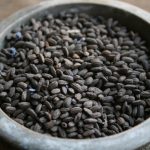
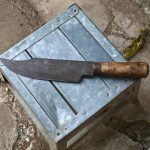
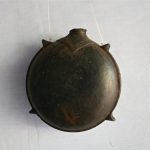
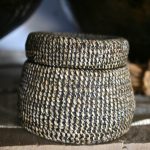
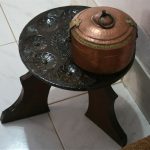
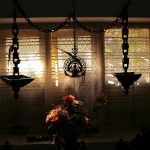
Very interesting – looking forward to more interviews like this one – it is really good to see the perspective of other people who love food and related things as much as we do!
Thanks, Kay!
Prof. Appanna really has a keen eye for the quotidian object. There was one time when he spotted what he recognized was a part of a “nool-puttu” maker sticking out of the ground where it had been turned into a makeshift cricket stump. He managed to unearth it and find the rest of it somewhere in the vicinity and put it back together!
What a beautifully done blog! Fantastic photography & layout, and I never flatter!!!
This interview moved me at so many levels. Shri Appana has the face of OLD INDIA, that will be gone in another generation. The whole facial expression & body language, perhaps much like his honored mother, speaks of a soul and a will cultivated in a particular way.
Another level: I have lived a part of his experience at 7800 feet, Landour, Mussoorie, marauding leopards and poor villagers going after them with mere rocks to save livestock in winter. The women, emaciated by absence of food, cutting grass on impossibly steep slopes alive with amazing flowers (occasionally surprising an angry bear) and carrying home loads almost their own weight. Searching for twigs & anything inflammable for hours.
I seem to remember a video travelogue [Highway On My Plate??] of Coorg that showed a house or hotel exhibiting a huge collection of the celebrated warrior’s blades. Another was a shop selling bottled of various fruit preserves and the like, the labels carefully hand-labelled. In Madikeri? At the time, and even now, I had been driven by the idea of re-establishing the botanical collections of the British period that we have left to perish and supplementing them with the finest fruits from the Fairchild Tropical collection in the USA, suitably virus-indexed.
There is a need for retired army men & families to explore income possibilities. Value added horticulture can offer one solution. I saw small bottles of passionflower sitting on the counter and felt sad thinking of the amount of effort spent versus returns. That needs to change for the better. We have an employment & income issue for many families.
There are so many varieties of Passionflower, and so much can be grown in a small space. We can have a BUTTERFLY PARK in Coorg, and generate ecotourism in controlled ways. This creation of what we call a Clonal Germplasm Collection or simply, a living collection of the finest tropical fruit, is a project that can create a lot of trained scientists out of Coorg natives plus be of great value in the future. Given that there are so many Defense folk out there, surely they understand how to wield the levers of Delhi to get things done!!
A very warm welcome, Gautam, and thank you for the kind words!
Yes, Prof. Appanna definitely fits your description, and in person too. He has many more such interesting stories to tell, as I know you do .I hope you’ll share more of your experiences in Landour and other places with us.
The joys of youtube- here is the shopping segment from HOMP as it seems to be popularly known.
Most of these products are made by enterprising individuals and sold through local stores. There is a growing influx of tourists, not necessarily the eco -friendly kind, and the demand for such home made goods is high from what I gather. Still, production it’s not anywhere close to where it could be and a lot of wonderful produce goes waste for lack of proper marketing.
Passion fruit grows like a weed here and avocados thrive too, as you know. I love the idea of a butterfly park! Hold those excellent thoughts till l get to another specific post!
It’s great to have you here:-)
What an amazingly charming write up Shalini. The sensitivity of your writing took me to a complete flashbacks mode, into my childhood, the beautiful bedtime stories that comprised of all the hair raising adventures of my father’s childhood life.
There couldn’t have been a better justice to Prof.Appanna’s passion towards the heritage of Kodagu than what you have captured in this blog. The layout of each of the antique piece, makes you feel like it has a story to tell. It is wonderful to know that these precious little collections are captured and made part of the blog.
As one of the above response to the blog reads, this interview has touched me at many different levels. The innocence and the simplicity of the generation that Prof. Appanna comes from and how someone from a way younger generation as you share the same passion.
Keep up your great work Shalini, your gift of writing is somthing that you should be extremely proud of. I have passed on the link to our friends and family that I know would thoroughly enjoy reading it. All the best with all your work.
Welcome, Vindhya, it’s great to see you here!
And Thank You for those kind words.:-)
It’s always a pleasure to spend time with people as knowledgeable and generous as your parents . Besides his collection, Professor Appanna has such a wealth of information about life in Coorg that I hope I can highlight in future posts.
Your father really is a gifted story teller, so I can quite imagine your childhood being filled with exciting “Tales from Iruli Bana”! Now you make sure you pass those on to the next generation 🙂
Thanks for taking the time to drop by- I hope you’ll keep visiting!
Is the clay steamer double walled or double based?? Such a good idea!
You’re right, it is a double base really. It’s a great idea- making one?